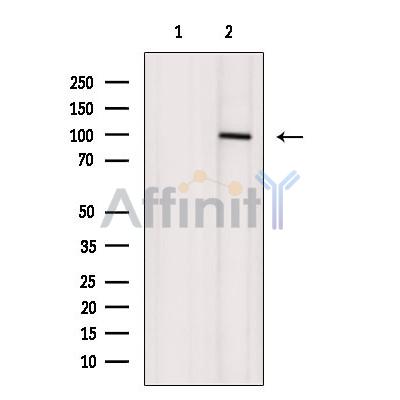ADAM12 Antibody - #DF12017
| 製品: | ADAM12 Antibody |
| カタログ: | DF12017 |
| タンパク質の説明: | Rabbit polyclonal antibody to ADAM12 |
| アプリケーション: | WB IHC |
| Cited expt.: | IHC |
| 反応性: | Human, Mouse |
| 分子量: | 97 kDa,68 kDa; 100kD(Calculated). |
| ユニプロット: | O43184 |
| RRID: | AB_2844822 |
製品説明
*The optimal dilutions should be determined by the end user.
*Tips:
WB: For western blot detection of denatured protein samples. IHC: For immunohistochemical detection of paraffin sections (IHC-p) or frozen sections (IHC-f) of tissue samples. IF/ICC: For immunofluorescence detection of cell samples. ELISA(peptide): For ELISA detection of antigenic peptide.
引用形式: Affinity Biosciences Cat# DF12017, RRID:AB_2844822.
折りたたみ/展開
A disintegrin and metalloproteinase domain 12; ADA12_HUMAN; ADAM 12; ADAM metallopeptidase domain 12; ADAM12; CAR10; Disintegrin and metalloproteinase domain-containing protein 12; MCMP; MCMPMltna; Meltrin alpha; Meltrin-alpha; Metalloprotease disintegrin 12 transmembrane; MLTN; MLTNA; OTTHUMP00000046766;
免疫原
A synthesized peptide derived from human ADAM12, corresponding to a region within N-terminal amino acids.
Isoform 1 is expressed in placenta and skeletal, cardiac, and smooth muscle. Isoform 2 seems to be expressed only in placenta or in embryo and fetus. Both forms were expressed in some tumor cells lines. Not detected in brain, lung, liver, kidney or pancreas.
- O43184 ADA12_HUMAN:
- Protein BLAST With
- NCBI/
- ExPASy/
- Uniprot
MAARPLPVSPARALLLALAGALLAPCEARGVSLWNQGRADEVVSASVGSGDLWIPVKSFDSKNHPEVLNIRLQRESKELIINLERNEGLIASSFTETHYLQDGTDVSLARNYTVILGHCYYHGHVRGYSDSAVSLSTCSGLRGLIVFENESYVLEPMKSATNRYKLFPAKKLKSVRGSCGSHHNTPNLAAKNVFPPPSQTWARRHKRETLKATKYVELVIVADNREFQRQGKDLEKVKQRLIEIANHVDKFYRPLNIRIVLVGVEVWNDMDKCSVSQDPFTSLHEFLDWRKMKLLPRKSHDNAQLVSGVYFQGTTIGMAPIMSMCTADQSGGIVMDHSDNPLGAAVTLAHELGHNFGMNHDTLDRGCSCQMAVEKGGCIMNASTGYPFPMVFSSCSRKDLETSLEKGMGVCLFNLPEVRESFGGQKCGNRFVEEGEECDCGEPEECMNRCCNATTCTLKPDAVCAHGLCCEDCQLKPAGTACRDSSNSCDLPEFCTGASPHCPANVYLHDGHSCQDVDGYCYNGICQTHEQQCVTLWGPGAKPAPGICFERVNSAGDPYGNCGKVSKSSFAKCEMRDAKCGKIQCQGGASRPVIGTNAVSIETNIPLQQGGRILCRGTHVYLGDDMPDPGLVLAGTKCADGKICLNRQCQNISVFGVHECAMQCHGRGVCNNRKNCHCEAHWAPPFCDKFGFGGSTDSGPIRQADNQGLTIGILVTILCLLAAGFVVYLKRKTLIRLLFTNKKTTIEKLRCVRPSRPPRGFQPCQAHLGHLGKGLMRKPPDSYPPKDNPRRLLQCQNVDISRPLNGLNVPQPQSTQRVLPPLHRAPRAPSVPARPLPAKPALRQAQGTCKPNPPQKPLPADPLARTTRLTHALARTPGQWETGLRLAPLRPAPQYPHQVPRSTHTAYIK
研究背景
Involved in skeletal muscle regeneration, specifically at the onset of cell fusion. Also involved in macrophage-derived giant cells (MGC) and osteoclast formation from mononuclear precursors (By similarity).
The precursor is cleaved by a furin endopeptidase.
Cell membrane>Single-pass type I membrane protein.
Secreted.
Secreted.
Secreted.
Isoform 1 is expressed in placenta and skeletal, cardiac, and smooth muscle. Isoform 2 seems to be expressed only in placenta or in embryo and fetus. Both forms were expressed in some tumor cells lines. Not detected in brain, lung, liver, kidney or pancreas.
The cysteine-rich domain supports cell adhesion through syndecans and triggers signaling events that lead to beta-1 integrin-dependent cell spreading. In carcinomas cells the binding of this domain to syndecans does not allow the integrin-mediated cell spreading.
The conserved cysteine present in the cysteine-switch motif binds the catalytic zinc ion, thus inhibiting the enzyme. The dissociation of the cysteine from the zinc ion upon the activation-peptide release activates the enzyme.
参考文献
Application: IHC Species: Human Sample: AE samples
Restrictive clause
Affinity Biosciences tests all products strictly. Citations are provided as a resource for additional applications that have not been validated by Affinity Biosciences. Please choose the appropriate format for each application and consult Materials and Methods sections for additional details about the use of any product in these publications.
For Research Use Only.
Not for use in diagnostic or therapeutic procedures. Not for resale. Not for distribution without written consent. Affinity Biosciences will not be held responsible for patent infringement or other violations that may occur with the use of our products. Affinity Biosciences, Affinity Biosciences Logo and all other trademarks are the property of Affinity Biosciences LTD.



![Figure 5. Immunohistochemical analysis of CD34, vascular endothelial growth factor (VEGF), and angiogenesis-related differentially expressed genes in the experimental (alveolar echinococcosis [AE]) and control (AE control group [AEC]) group samples. (A) CD34 and VEGF staining in AE samples showed different degrees of vascularization. Increased expression of SPP1, RSPO3, APLN, TWIST1, ADAM12, and FOXC2 was observed in the AE samples, whereas low or no expression of these genes was observed in the AEC samples. (B) The H-scores of CD34, VEGF, SPP1, RSPO3, APLN, TWIST1, ADAM12, and FOXC2 were significantly higher in the AE samples than in the AEC samples (values represent the mean ± standard error of the mean: ∗∗∗P < .001, ∗∗∗∗P < .0001). ADAM12 Antibody - Figure 5.](http://img.affbiotech.cn/uploads/202309/c403b63a188590dab24ca3dd823291ee.png)